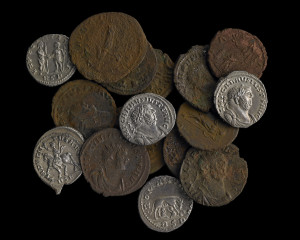 From ‘Treasure Island‘ to ‘Pirates of the Caribbean’, via ‘King Solomon’s Mines‘ and almost anything written by Dan Brown, the search for hidden treasure, of whatever kind, has been a fiction fundamental. So I couldn’t pass up a visit to an exhibition on treasure or ‘Hoards’ when I saw one.
From ‘Treasure Island‘ to ‘Pirates of the Caribbean’, via ‘King Solomon’s Mines‘ and almost anything written by Dan Brown, the search for hidden treasure, of whatever kind, has been a fiction fundamental. So I couldn’t pass up a visit to an exhibition on treasure or ‘Hoards’ when I saw one.
‘Hoards; a hidden history of ancient Britain’ can be found on the third floor of the British Museum in Room 69a. This is only a small room, but it contains pieces from a variety of hoards found across Britain. Many are pre-historic, from the Bronze or Iron Ages, when people placed precious objects in ground or water as part of ritual practices, of worship, of appeasement, or attaching to a particular event or deceased person. A hoard found in the Thames at Broadness (c.1000 – 750 BCE) is Bronze Age. Pieces from the Salisbury Hoard (c.200-100 BCE) represent the Iron Age. These hoards were never meant to be found or dug up. The Bronze Age gold and silver rings, together with their metal pouch ( see right) should have lain in the earth for ever, were it not for an archaeological dig.
were never meant to be found or dug up. The Bronze Age gold and silver rings, together with their metal pouch ( see right) should have lain in the earth for ever, were it not for an archaeological dig.
Later hoards, it is assumed, were intended to be retrieved. These were buried in reaction to war or economic upheaval. The hoard found in 2011 at Bitterley, south Shropshire, is of silver coins from the period of the English Civil War. This was assumed to have been buried to hide it from advancing opposition forces (or the looters who followed them). Similarly the Cheapside Hoard, comprising more than 400 pieces of Elizabethan or Jacobean jewellery, was buried during the same war. We know more about this hoard as the place where it was found was formerly known as Goldsmith’s Row and was the home and workplace of a known goldsmith. This was probably his stock. What was his story?
Invasion threats, too, prompted people to bury their valuables, as late as the Second World War. A hoard of US dollars was found buried in the East End of London post-war, their owner having either forgotten where he/she put them, or having met their final fate. We don’t know. But burying them was a way of preserving your riches. Or preserving the means with which you will make more riches. One of the most fascinating exhibits for me was the forgers equipment  (and try-outs) found buried at Fenny Stratford ( see urns, tools, etc. left ). The forger was Roman.
(and try-outs) found buried at Fenny Stratford ( see urns, tools, etc. left ). The forger was Roman.
There are many hoards of Roman coins. The Frome hoard, from which there are pieces in the exhibition, was found in 2010 and is one of the biggest hoards of Roman coins thus far found. Some 52,530 coins were discovered in a large pot. They are largely silver or bronze and are dated from 253 to 305 CE. Unlike many hoards of the period the range of coins in this hoard and their different ages suggest that this was a votive hoard, containing contributions from many people over a period of time and was meant as an offering to the gods. The pot was a fragile one and any attempt to dig it up using traditional method would have led to it shattering and the coins being dispersed. What events prompted such an offering? Another story.
So what do you do if you find a hoard?
The 1996 Treasure Act ( yes, that is a real piece of legislation ) states that any finder of a legally defined treasure must report their find to the local coroner within fourteen days. The coroner then holds an inquest, just as if the treasure was a found body, to determine if what has been found is treasure. If it is, the finder must offer it for sale to a museum at a price set by independent valuers ( no hoarding it for yourself, you’ll notice ).
And where should you look?
All over Britain, if this exhibition is anything to go by. But Suffolk seems to have more than its share. See you at Kings Cross (and bring a metal detector).
The exhibition is based on work by the British Museum and Leicester University research project Crisis or Continuity: Hoarding in Iron Age and Roman Britain.
If you enjoyed reading this article you may also enjoy The First Library In the beginning…... The Prospect of Whitby A Walk on the Wild Side


 RSS – Posts
RSS – Posts